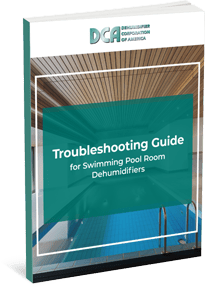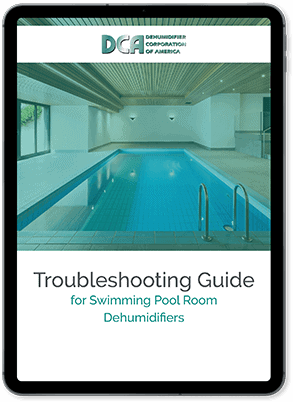Dedicated Outdoor Air Systems (DOAS): The Ultimate Solution For Controlling Excessive Humidity Found When Introducing Outdoor Make-up Air Into Buildings
As the importance of indoor air quality (IAQ) and energy efficiency continues to grow, building owners and facility managers are seeking innovative solutions to provide a healthy and comfortable indoor environment while reducing energy consumption. One such solution is the Dedicated Outdoor Air System (DOAS), a specialized HVAC system designed to provide a dedicated stream of conditioned outdoor air to a building while removing excessive moisture and adding room heating or cooling as needed.
Why a Dedicated Outdoor Air System is Needed?
Through the years it became apparent that indoor air quality had to include dehumidification along with heating and cooling. Early on government standards mandated outdoor make-up air to be introduced into public buildings. Originally, outside air was introduced into the return air portion of the building’s HVAC system and heated and cooled as needed. A building exhaust system then dispersed the stale air outdoors. The turning point, for needing better control of incoming moisture, came in 1976 when the American Legion met for their annual convention in Philadelphia and many of the attendees suffered legionella bacteria disease which had symptoms similar to pneumonia. The problem was traced back to the building’s A/C chiller system. Up until that point the buildings HVAC system alone had to deal with excessive and it found that mold and mildew could and did build up on the evaporator coil, condensate stream and in the ductwork possibly leading to Legionnaires disease. Something had to change.
Although many parts of the country have outside air that is relatively dry year round, most parts have some months of excessive humidity that has to be dealt with. The need for a separate dehumidification system, that dealt only with conditioning outdoor air before it enters the building, was needed. Its sole purpose was to remove excessive humidity while having the capability to add heating or cooling to the building as needed.
What is a Dedicated Outdoor Air System?
A DOAS dehumidifier is a separate HVAC system that focuses solely on providing conditioned dry outdoor air into a building, rather than relying on the building’s main HVAC system to handle excessive humidity. This dedicated system is primarily designed to remove excessive humidity from the outdoor air before it enters the building. By separating the outdoor air handling from the space cooling and heating functions, DOAS systems can provide a more efficient and effective solution for maintaining a healthy and comfortable indoor environment.
Components of a Dedicated Outdoor Air System:
A typical DOAS system’s primary function is to remove excessive moisture and add heating or cooling in the process.. It differs from air conditioning in the fact that its evaporator coil is biased towards removing moisture as its primary function, and less cooling from the same system. While air conditioning’s primary function is to provide cool air, it is much less efficient in removing moisture. When the air conditioning system will not provide the dew point or relative humidity that is needed a DOAS is the answer.
Benefits of DOAS:
Improved Indoor Air Quality (IAQ): By providing a dedicated stream of dry, heated or cooled outdoor air to the room or building. Dedicated outdoor air systems can improve IAQ by removing moisture from the air and can reduce run time on the central HVAC system.
Increased Energy Efficiency: Dedicated outdoor air systems can reduce energy consumption by separating the outdoor air handling from the space cooling and heating functions, allowing for more efficient operation.
Better Humidity Control: Dedicated outdoor air systems can provide more precise humidity control, which is essential in humid climates or applications with high humidity requirements.
Dedicated outdoor air systems greatly reduce the probability of room air contamination caused by excessive humidity and or compromised normal A/C systems and the build up of ductwork mold and mildew.
Reduced Maintenance: With a dedicated system, maintenance is simplified, and the risk of contamination from the main HVAC system is minimized.
Flexibility and Scalability: DOAS can be designed to meet specific building requirements both large and small making them a flexible and scalable solution.
Applications of Dedicated Outdoor Air Systems:
DOAS are suitable for a wide range of applications, including, but not limited to::
Commercial Buildings, office buildings and other applications: that are located in high dew point areas such as any of the coastal states where bringing in outdoor air only add to the total moisture load.
Commercial indoor pools and spas located in hotels and motels. Ideal to condition hallways, corridors and office space where the effects of the indoor pool or hot tub atmosphere intrude into these areas.
In many cases it is advisable to decouple the outdoor make-up air dehumidification from the dehumidification system that controls the load coming from the swimming pool or spa. Many times the make-up air moisture load is larger than the moisture load coming from the swimming pool.
Healthcare, small hospitals or urgent care centers where common air conditioning is underperforming for maintaining low dew point conditions needed.
Educational Institutions, schools and libraries: where dryer conditions are needed over and above what air conditioning can provide.
Data Centers: DOAS can help maintain a stable and controlled environment in data centers, which is critical for sensitive electronic equipment.
Custom applications: where standard catalog dehumidification systems fail.. Our dehumidification engineers are particularly adept in designing a system for your unique application both large or small.
Challenges and Considerations When Looking At A DOA system:
While dedicated outdoor air systems offer several benefits, there are some challenges and considerations to keep in mind:
Higher Upfront Costs: DOAS can be more expensive to install than traditional HVAC systems.
Space Requirements: Dedicated outdoor air systems can be installed indoors or outdoors as needed.
Dedicated outdoor air systems do not remove odors or very fine particles particulate matter without adding a dedicated odor control pre-filter.
Design and Installation: Proper design and installation are crucial to ensure the DOAS operates efficiently and effectively.
Dedicate Outdoor Air Systems Are A Good Choice
In conclusion, DOAS offer a dedicated solution for outdoor air handling, providing improved IAQ, energy efficiency, and humidity control. By understanding the benefits, components, and applications of DOAS, building owners and facility managers can make informed decisions about implementing this innovative technology in their buildings. With the growing importance of IAQ and energy efficiency, dedicated outdoor air systems are poised to become a crucial component of modern building design and operation.
























